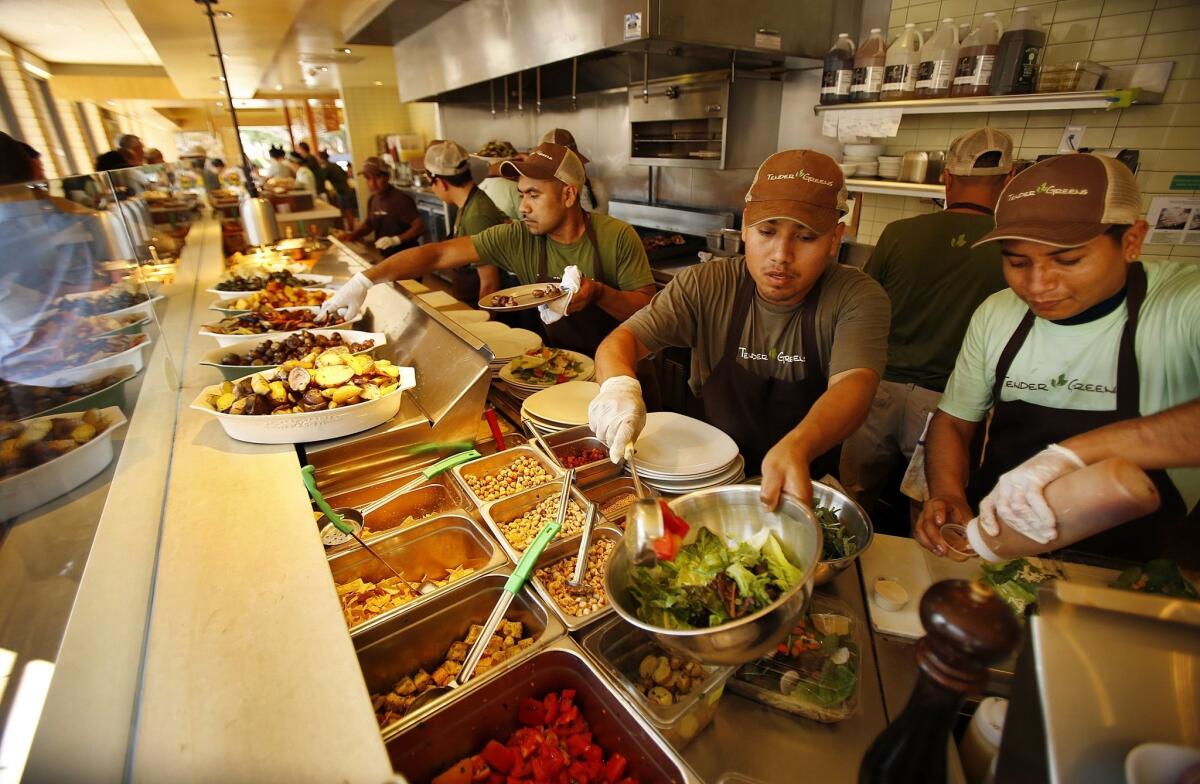California’s low-wage workers earn less than in 1979, study shows

Food preparation workers and restaurant servers are among the low-wage employees studied by UC Berkeley researchers. Above, salad makers prepare lunch at Tender Greens in Santa Monica last year.
California’s low-wage workers are older and more educated than they were three decades ago — but they earn less, according to new research from UC Berkeley.
The study, released Thursday, documented the extensive growth of income inequality in California since the late 1970s. The researchers’ data showed that California workers at the lowest end of the pay scale have seen significant declines in their earnings over the last three decades, after adjusting for inflation. Workers in the highest income brackets, meanwhile, have seen enormous gains.
For example, the bottom 20% of workers have seen inflation-adjusted wages decline 12% since 1979, while the top 10% of California workers have seen wages grow 35%.
“We are seeing the hollowing out of middle-wage jobs over time,” said Annette Bernhardt, a visiting researcher at UC Berkeley’s Institute for Research on Labor and Employment, who worked on the report.
The trend is happening even as low-wage workers as a whole are becoming more educated and have more work experience.
About 44% of low-wage workers in California were older than 35 last year, while in 1979 only 32% of workers were that old. Teenagers also make up a much lower share of the low-wage workforce — 5%, compared with 16% in 1979.
Nearly half of low-wage workers had at least some college education last year, compared with 39% in the late 1970s.
The report defines “low-wage” as those in California who made less than $13.63 an hour in 2014, which is two-thirds of the state’s median wage. More than 4.7 million workers in California fit that description — a third of the state’s workforce.
Southern California has a much higher share of low-wage workers — 37% of the workforce — than other major population centers in the state.
By contrast, only 25% of the Bay Area’s workers are considered low-wage; in Sacramento, the share is 32%.
Economic data show the situation isn’t likely to change any time soon. Projections for California’s job market in 2022 show that the mix of jobs in each industry will be relatively the same.
“Economies change slowly,” Bernhardt said. “It would not be wise to hope that California is going to magically outgrow its low-wage jobs problem in the next 20 years. That is going to take concerted public policy changes.”
The report shows that of the 10 occupations expected to add the most new jobs through 2022, seven are in low-wage positions making less than $12 an hour.
The top five occupations expected to add the most jobs through 2022 are personal care aides, food preparation workers, retail sales workers, warehouse workers and restaurant servers.
In addition to declining wages, low-wage workers are also contending with an erosion of their benefits.
Since 1980, the share of low-wage workers with health insurance benefits has fallen by half, and the share with pension benefits has fallen almost one-fourth.
More to Read
Inside the business of entertainment
The Wide Shot brings you news, analysis and insights on everything from streaming wars to production — and what it all means for the future.
You may occasionally receive promotional content from the Los Angeles Times.











